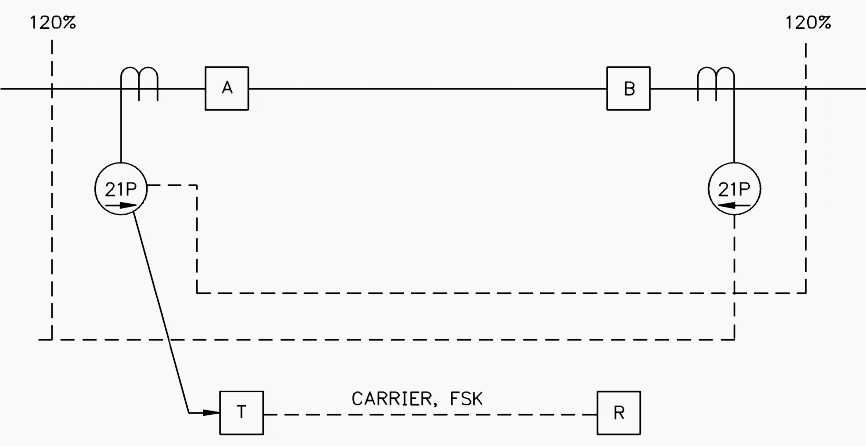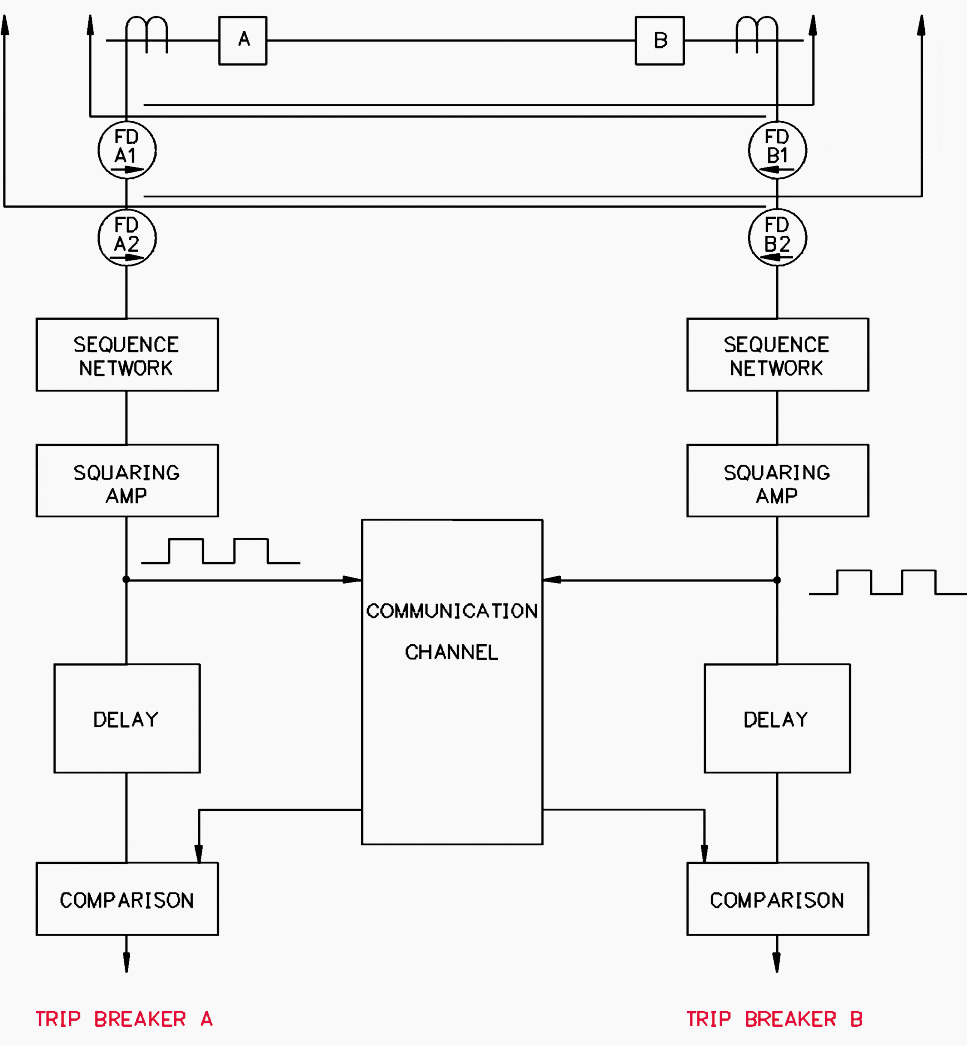When do we use pilot schemes?
Pilot schemes simultaneously measure and monitor system parameters at all terminals of a transmission line, local and remote, and then respond according to their predetermined functions. These schemes require the use of a communications channel that may be provided through pilot wires, microwave, fiber, or power line carrier.

If the measured parameters exceed threshold values, appropriate actions are initiated.
Pilot schemes can generally be broken into two primary categories. Those categories are directional comparison and phase comparison. Directional schemes use directional distance relays for phase fault detection and either directional distance relays or directional overcurrent relays for ground fault detection.
The decision to trip is based on relay setting thresholds being exceeded and the faults being located in the predetermined direction for trip.
Phase comparison schemes are inherently directional and secure, not tripping for faults outside the protected zone of protection.
1. Directional Comparison
Directional comparison schemes are divided into four categories:
1.1 Blocking Schemes
Directional comparison blocking uses distance relays as directional indicators and block initiation for phase faults. Either distance or directional overcurrent relays may be used for ground fault indicators and block initiation.
Each terminal has trip and start relays. The trip relay reaches toward the remote terminal and a little beyond. The start relay reaches backwards, away from the protected section. The trip relay attempts tripping when it operates unless it is stopped by receipt of a blocking signal (carrier, audio tone, or microwave) from the remote end. The start relays at each end initiate the blocking signal.
Thus, if only the trip relays see the fault, it is within the protected section and both ends trip. If the fault is just outside one end, the start relays at that end operate and send a block signal to the remote end, which would otherwise trip. The ground relays operate similarly.
The communication channel is not required for tripping the breakers since the breakers will trip in the absence of the blocking signal. Failure of the channel could result in overtripping of the breakers for adjacent line faults within the reach setting of the distance relays.
Blocking directional comparison is commonly used with on/off type carrier facilities. Since it is not necessary to drive a signal through a fault to operate this scheme, it is the most popular carrier relaying system. See Figure 1.


1.2 Unblocking Schemes
Directional comparison unblocking is similar to the blocking scheme except that the start relays are deleted and the blocking, “guard” signal is sent continuously. See Figure 2.
The communication signal for an unblocking scheme uses a frequency shift keying (FSK) channel.
For an internal fault, the frequency is shifted to the unblock, “trip” frequency. The receivers receive the trip frequency and close the output contact, which in series with the 21P relay output contact will trip the breaker.
For an external fault, within the reach of one of the 21P relays, the distant 21P relay will see the fault while the local 21P relay will not see the fault since it is behind the relay.
The distant 21P relay will shift its transmitter frequency to trip.
The local 21P relay will not send the trip frequency or close the 21P output contacts. The line thus stays in service. Should the receivers fail to receive a guard signal and a trip signal, the receivers will allow typically 150 msec of receiver contact closure to permit the 21P relay contact to trip the line.
After this time limit, the communication channel will lock out.


This scheme is more secure since overtripping is avoided at all times with the exception of the 150-msec interval during the loss of signal. Reliability is improved since the communication channel operates continuously and can be monitored, providing an alarm in the case of failure.
The scheme is applicable for two-terminal and multi-terminal lines. Separate channels are required between each pair of line terminals.
1.3 Overreaching Transfer Trip Schemes
Permissive overreach is also a simple scheme, requiring only one overreaching fault detector at each terminal. This fault detector sends both a trip signal and attempts local tripping through a contact on the receiver.
If both relays see a fault, both ends trip simultaneously.
These channels are normally used with audio tones with frequency shift keying over microwave, leased line, or fiber-optic communications.
The overreaching transfer trip scheme provides highly secure transmission line protection since a trip signal is required from both ends of the line for tripping to occur. The dependability of the scheme may be less than the blocking schemes since the trip signal has to be received before the tripping is initiated.
The scheme is often used when an existing non-piloted scheme has communications added for piloting.
1.4 Underreaching Transfer Trip Schemes
Underreaching transfer trip schemes include two variations: direct underreach and permissive underreach.
The communications for this type of relaying are generally the same as for the overreaching systems, using audio tones with frequency shift keying over microwave, leased line, or fiberoptic communications channels.
1.4.1 Direct Underreach
This form of protection requires only a single distance fault detector at each end. It has to be set short of the remote end and will simultaneously trip the local breaker and send a trip signal to the remote end, which then trips directly upon receipt of the signal.
Note that local confirmation is not required upon receipt of a trip signal.
See Figure 3.


1.4.2 Permissive Underreach
This scheme is identical to the direct underreach scheme with the addition of an overreaching fault detector. The transfer trip signal requires local confirmation by this fault detector before tripping can occur. This increases the security of the scheme and the consequent range of application.
It is commonly selected when an existing step distance relay line is to have the pilot added. See Figure 4.
Carrier is not normally used since a fault could short out the communication signal and prevent the signal from reaching the remote terminal.


2. Phase Comparison
Phase comparison relay systems monitor the current direction at each line terminal of the protected line and transmit this information to the other terminal via a communication channel.
Each line terminal compares local and remote current direction and trips if the current is into the line from both terminals. The communication channel is normally an on/off type of communications, transmitting only when the overcurrent detector’s thresholds have been exceeded.
Current or distance fault detectors are used to supervise tripping. These detectors have to be set above line charging current, which can appear to the relays as an internal fault at low loads. Internal timers have to be set to compensate for the transit time of the communication channel.
One of the most popular applications of this system is on lines with series capacitors because it is less likely that such a current-operated scheme will operate incorrectly for faults near the capacitors.
2.1 Pilot Wire
This scheme is a form of phase comparison since it compares current direction at each terminal. The difference between this scheme and others is that a pair of telephone wires is used as the communication channel.
A special filter in the relay converts the three-phase currents to a single-phase voltage and applies this voltage to the wires. When current flows through the protected section, the voltages at each end oppose each other and no current flows in the operate coils.
Special monitor relays sound an alarm if the pilot wire pair becomes open or shorted. The wire line has to have adequate protection against induced voltages and a rise in station ground potential but may not use carbon block protectors because the line has to remain in service while the protection is operating.
Neutralizing transformers and gas tubes with mutual drainage reactors, all with adequate voltage ratings, comprise the preferred pilot wire protection package.
This relaying has the advantage of simplicity and does not require a potential source. It does not provide backup protection.
Its application is limited to short lines a mile or so in length because of pilot wire cost and increased exposure. The system’s dependability is based on the integrity of the pilot wires themselves.
Recently, pilot wire systems have been replaced with fiber-optic systems providing the communications systems, using a module to convert the output voltage to a light signal. These modified systems have provided a more dependable and secure protection system.
2.2 Single-Phase Comparison
This scheme applies a sequencing network to the current inputs to the relay to produce a single-phase voltage output. This output is proportional to the positive, negative, and zero phase sequence components of the input currents.
This signal is squared so that the positive portion of the signal provides the positive portion of the square wave.
See Figure 5.
Normally current-operated units are used as the fault detectors. In a case where the fault current is less than the load current, impedance-operated units may be used for fault detection.
The use of impedance fault detectors will increase the cost of the system because of the necessity of having line potentials for the operation of the relay.


2.3 Dual-Phase Comparison
This scheme is similar to the single-phase comparison scheme except that square wave signals are developed for the positive and the negative portions of the single-phase voltage output of the sequencing network. Each signal requires a separate channel for the transmission of information to the remote site.
This scheme can provide a slightly higher speed of detection since faults are detected on both the positive and the negative portions of the single-phase voltage output of the sequencing network.
This scheme is normally used with a frequency-shift channel, which is continuously transmitted. On a power line carrier it is configured as an unblocking scheme.
2.4 Segregated Phase Comparison
This scheme is similar to the single-phase comparison scheme except that a square wave is developed for each phase of the transmission line. A communication channel is required for each phase to provide communications to the remote terminal.
Comparisons are made on each of the three phases. The operation of the scheme is basically as described above in the previous phase comparison schemes.
Sources:
- Design Guide for Rural Substations by United States Department of Agriculture











Very useful
THIS PILOT SCHEME MAY GIVE US A REGULAR POWER .RATHER THAN POWER INTERRUPTION .